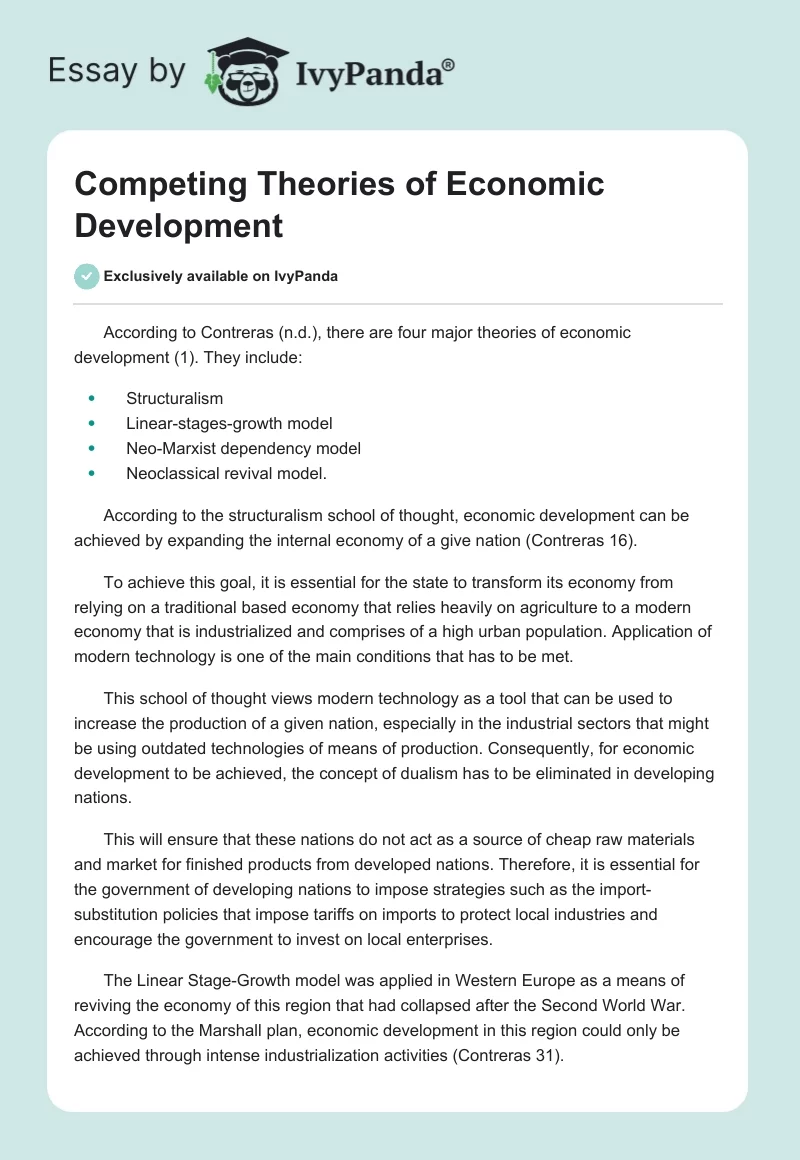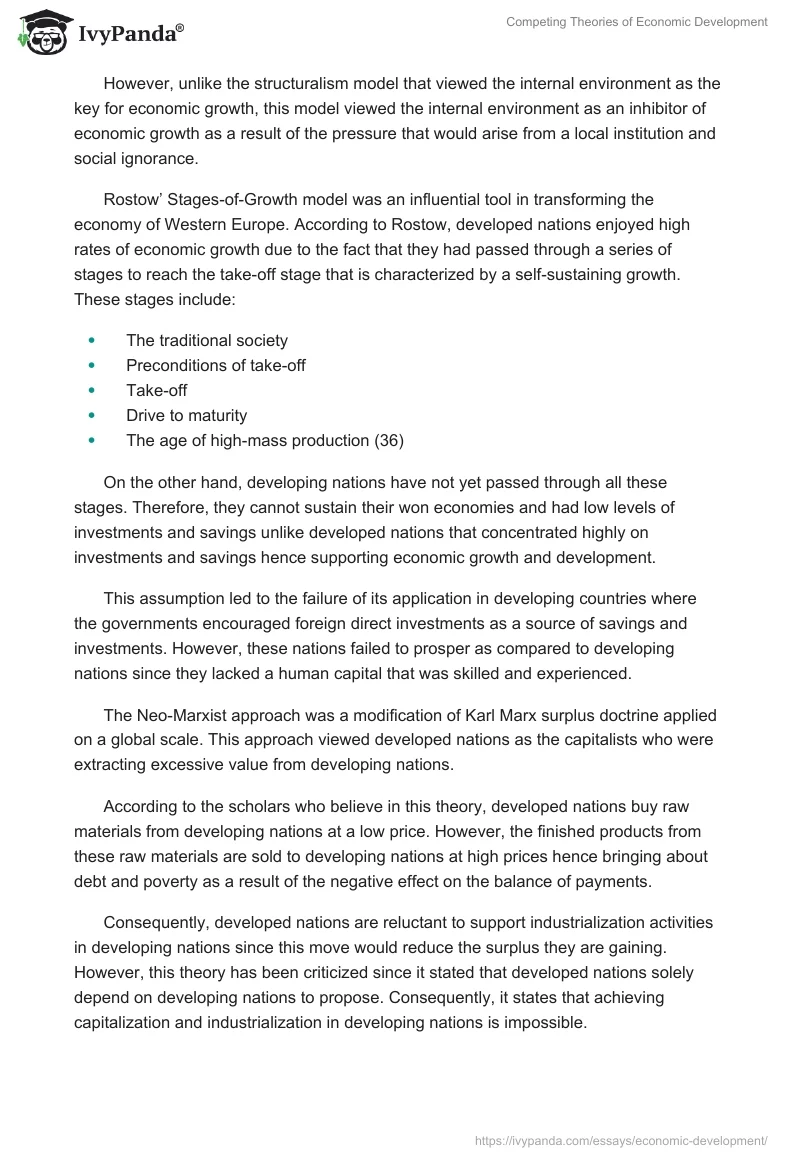According to Contreras (n.d.), there are four major theories of economic development (1). They include:
- Structuralism
- Linear-stages-growth model
- Neo-Marxist dependency model
- Neoclassical revival model.
According to the structuralism school of thought, economic development can be achieved by expanding the internal economy of a give nation (Contreras 16).
To achieve this goal, it is essential for the state to transform its economy from relying on a traditional based economy that relies heavily on agriculture to a modern economy that is industrialized and comprises of a high urban population. Application of modern technology is one of the main conditions that has to be met.
This school of thought views modern technology as a tool that can be used to increase the production of a given nation, especially in the industrial sectors that might be using outdated technologies of means of production. Consequently, for economic development to be achieved, the concept of dualism has to be eliminated in developing nations.
This will ensure that these nations do not act as a source of cheap raw materials and market for finished products from developed nations. Therefore, it is essential for the government of developing nations to impose strategies such as the import-substitution policies that impose tariffs on imports to protect local industries and encourage the government to invest on local enterprises.
The Linear Stage-Growth model was applied in Western Europe as a means of reviving the economy of this region that had collapsed after the Second World War. According to the Marshall plan, economic development in this region could only be achieved through intense industrialization activities (Contreras 31).
However, unlike the structuralism model that viewed the internal environment as the key for economic growth, this model viewed the internal environment as an inhibitor of economic growth as a result of the pressure that would arise from a local institution and social ignorance.
Rostow’ Stages-of-Growth model was an influential tool in transforming the economy of Western Europe. According to Rostow, developed nations enjoyed high rates of economic growth due to the fact that they had passed through a series of stages to reach the take-off stage that is characterized by a self-sustaining growth. These stages include:
- The traditional society
- Preconditions of take-off
- Take-off
- Drive to maturity
- The age of high-mass production (36)
On the other hand, developing nations have not yet passed through all these stages. Therefore, they cannot sustain their won economies and had low levels of investments and savings unlike developed nations that concentrated highly on investments and savings hence supporting economic growth and development.
This assumption led to the failure of its application in developing countries where the governments encouraged foreign direct investments as a source of savings and investments. However, these nations failed to prosper as compared to developing nations since they lacked a human capital that was skilled and experienced.
The Neo-Marxist approach was a modification of Karl Marx surplus doctrine applied on a global scale. This approach viewed developed nations as the capitalists who were extracting excessive value from developing nations.
According to the scholars who believe in this theory, developed nations buy raw materials from developing nations at a low price. However, the finished products from these raw materials are sold to developing nations at high prices hence bringing about debt and poverty as a result of the negative effect on the balance of payments.
Consequently, developed nations are reluctant to support industrialization activities in developing nations since this move would reduce the surplus they are gaining. However, this theory has been criticized since it stated that developed nations solely depend on developing nations to propose. Consequently, it states that achieving capitalization and industrialization in developing nations is impossible.
The neoclassical revival model dismissed the claims of the structuralism and Neo-Marxist models. Instead, it states that developmental challenges that are experienced in developing nations are due to poor policies and government intervention.
To averse this situation therefore, the government of developing nations should develop policies that encourage free trade, an efficient market, privatization of state owned enterprises. Most importantly, this model recommended that government intervention in trade and investments should be limited.
Millennial Development Goals
Millennial Development Goals (MDGs) are eight different goals that were set at the Millennial Summit that was attended by United Nations (UN) member states in the year 2000. The aim of these goals is to improve the overall well-being of individuals all across the world.
To achieve this vision, these goals focused on the social and economic factors that affect an individual and the overall global economy. Poverty eradication is one of the main goals that have to be achieved for this vision to be realized. In developing nations, poverty is a predicament that prevents economic growth and development. The inhabitants of these nations usually live under $1 per day.
However, poverty not only concerns itself with the income an individual earns but also the opportunities that he/she faces given the social and economic conditions of a given state. In most developing nations, the level of poverty has been enhanced as a result of social constraints that deprives individual the access of basic amenities such as shelter, education, and healthcare. Therefore, poverty can be regarded as a state of capability deprivation that hinders individuals from realizing their full potential.
Education is an essential component in achieving economic growth and development. It is essential for a nation to have a human workforce that has the skills and expertise to handle various economic, social, and political requirements. Education thus supports the realization of this requirement. Thus, it is the priority of every government in the world to provide primary education to its citizen.
It has always been stated that a nation is as healthy as its citizens. Thus, to achieve the MDGs, it is essential for governments especially in developing nations to ensure that its subjects have access to high quality medical services. The life expectancy of individuals in developing nations is slightly lower as compared to developed nations.
Consequently, the rate of maternal deaths and infant mortality are higher in developing nations as compared to developed states. Therefore, it is the duty of developing nations to come up with measures and policies that would ensure that its subjects have access to healthcare. In Cuban government for instance has set up universal entitlements to support education and healthcare.
Developed nations in Germany and North America on the other hand spend massively to support their education, healthcare programs, and social security. The USA for instance spends approximately 35-45% of its GDP to support these activities (Dreze and Sen 43). Therefore, developing nations need to increase their public expenditure to support education, healthcare, and social security programs.
Finally, MDGs aim at sustaining the global economy. To achieve this goal, the governments of member states have to ensure that their nations exhibit positive economic development and growth. To achieve this goal, it is essential for these nations to ensure that there is equitable distribution of resources within the economy.
Consequently, it is essential for member states to have positive diplomatic relations that would encourage trade and foreign investments. This will ultimately increase the level of savings and investments among member states hence supporting economic growth.
Works Cited
Contreras, Ricardo. Competing Theories of Economic Development. n.d. Web.
Dreze, Jean and A. Sen. India: Development Participation. Oxford: Oxford University Press, 2002. Print.


